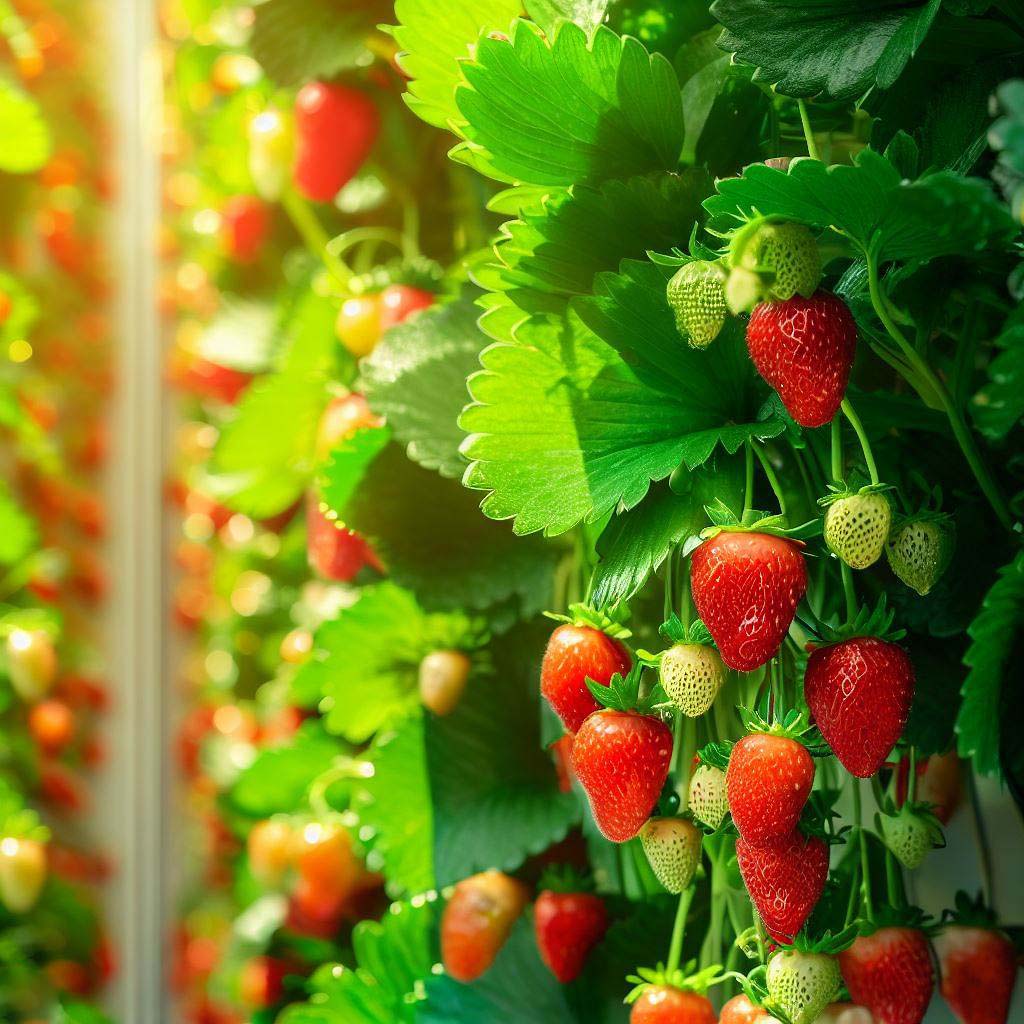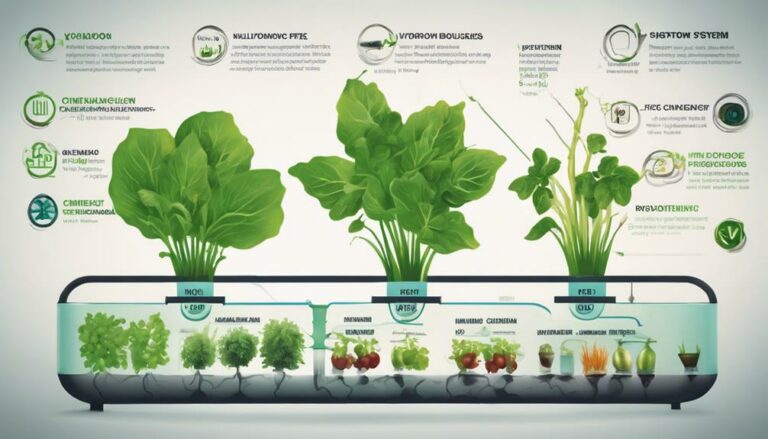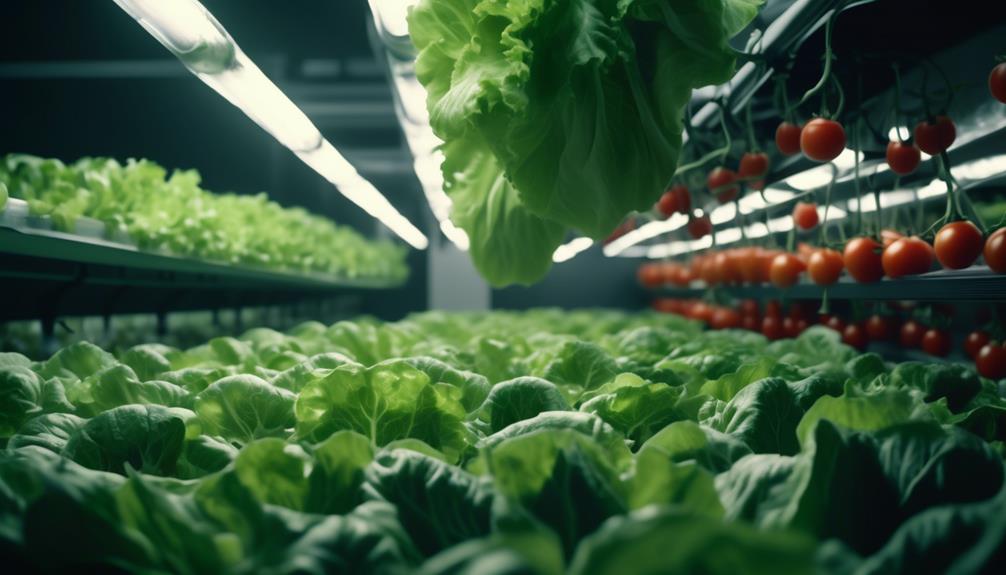Table of Contents
Strawberries are a popular and delicious fruit, packed with antioxidants, vitamin C, fiber, and other nutrients beneficial for health. However, traditional soil-based cultivation can pose challenges due to limited space, poor soil quality, or harsh weather conditions. That’s where hydroponics comes in. Hydroponic strawberry growing, a soilless method that uses water and nutrients, offers a year-round solution with less hassle and increased efficiency. In this comprehensive guide, I will take you through the process of growing hydroponic strawberries, including the benefits, challenges, setup, planting, care, harvesting, and storage. Let’s dive in!
What are Hydroponic Strawberries?
Hydroponic strawberries are strawberries cultivated without soil. Instead, they rely on a soilless medium, such as water infused with essential nutrients. Hydroponics is a horticultural technique that creates a controlled environment, allowing adjustments to factors like water, nutrients, light, temperature, pH, and oxygen. This optimization maximizes plant growth and yield. Hydroponics can be implemented indoors or outdoors, employing various systems and techniques.
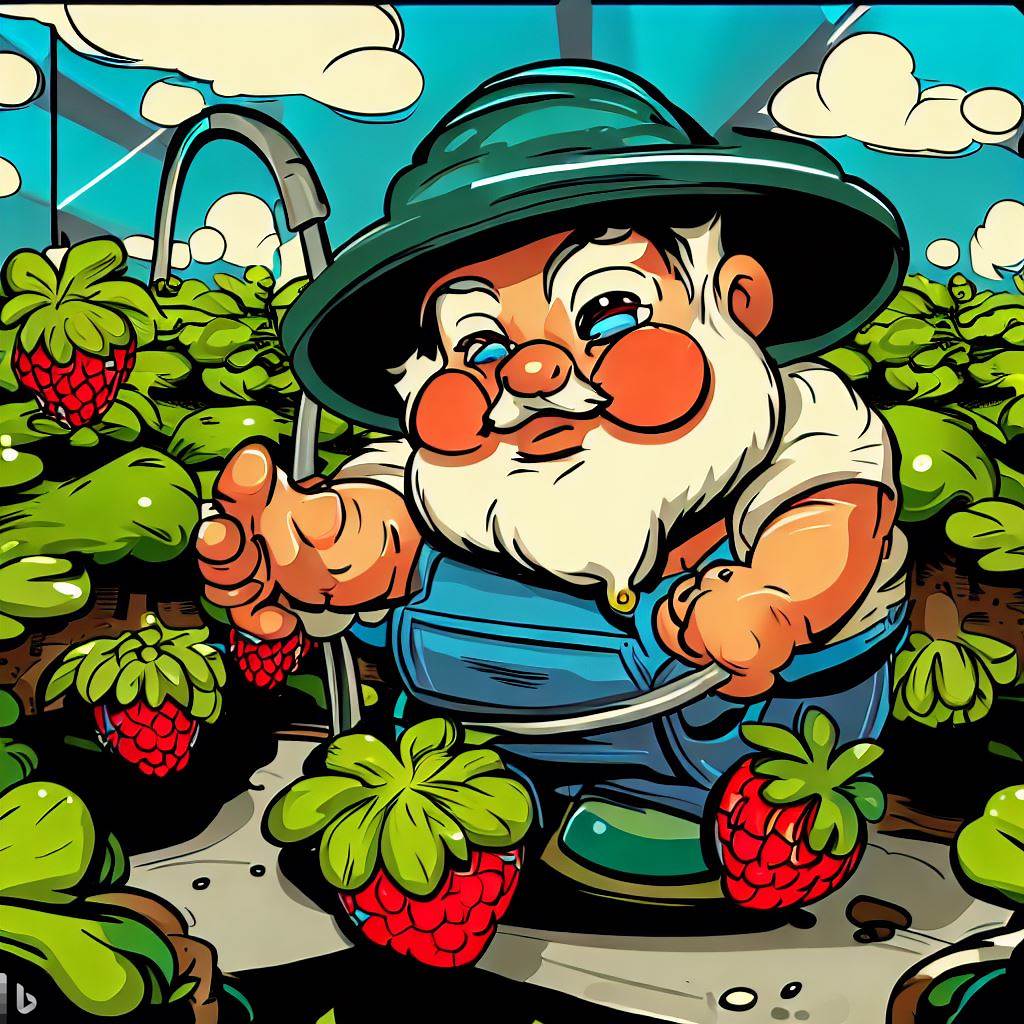
Why Choose Hydroponic Strawberries?
Opting for hydroponic strawberries brings several advantages compared to traditional soil-based cultivation. Let’s explore the benefits and challenges associated with hydroponic strawberry growing.
Benefits of Hydroponic Strawberries
- Higher Yield and Quality: Hydroponic strawberries can produce a greater number of fruits per plant due to consistent access to optimal water and nutrient levels. Moreover, they tend to be larger, sweeter, juicier, and more uniform in shape and color compared to soil-grown strawberries.
- Space and Resource Efficiency: Hydroponic strawberries require less space than their soil-grown counterparts since their root systems don’t require as much room to spread out. Additionally, hydroponic systems use less water and fertilizer due to reduced evaporation and runoff within closed systems.
- Reduced Labor and Maintenance: Hydroponic strawberries entail less work compared to soil-based cultivation. There’s no need for tasks like weeding, tilling, or mulching. Moreover, hydroponic strawberries face fewer pest and disease issues since they are less exposed to soil-borne pathogens and insects.
- Extended Growing Season: With hydroponic strawberries, you can grow them all year round, regardless of weather or climate conditions. Additionally, they offer more frequent harvesting opportunities due to their shorter planting-to-fruiting cycle.
Challenges of Hydroponic Strawberries
- Higher Initial Cost: Implementing hydroponic systems for strawberries involves higher upfront investment compared to traditional soil-based methods. Costs include setting up the system, purchasing materials, equipment, and covering electricity and water expenses. Furthermore, operating and monitoring the system requires additional technical knowledge and skills.
- Risk of Failure: Hydroponic strawberries are more vulnerable to system failures such as power outages, pump malfunctions, leaks, clogs, or nutrient imbalances compared to soil-grown strawberries. Maintaining optimal conditions by regularly checking pH, electrical conductivity (EC), temperature, and water levels is crucial.
Setting Up a Hydroponic System for Strawberries
Multiple hydroponic systems are suitable for growing strawberries. The following are commonly used options:
- Nutrient Film Technique (NFT): This system employs a continuous flow of nutrient solution through pipes or channels, with the plant roots suspended in the solution. Excess solution is collected and recirculated via a pump.
- Deep Water Culture (DWC): In this system, plants are suspended in net pots above a tank or bucket filled with nutrient solution. The roots are submerged and receive oxygen from an air pump and air stone.
- Ebb and Flow (Flood and Drain): This system utilizes trays or pots filled with an inert medium like perlite or clay pebbles. Nutrient solution periodically floods the tray or pot from a reservoir using a timed pump. Gravity then drains the solution back into the reservoir.
- Drip System: Plants in this system are placed in pots with an inert medium like coco coir or rockwool. Nutrient solution is delivered to the medium through a network of tubes connected to a reservoir. The solution drips onto the medium and reaches the roots.
Each system offers its own set of advantages and disadvantages based on budget, space availability, and personal preference. You can even customize your own system by combining elements from different systems.
Regardless of the system you choose, setting up your hydroponic strawberry cultivation requires basic materials and equipment:
- Reservoir or tank for the nutrient solution
- Pump to circulate the nutrient solution
- Timer to control the pump
- Optional: Air pump and air stone for oxygenation
- pH meter to measure acidity or alkalinity
- EC meter to measure electrical conductivity or salt content
- Thermometer to measure solution temperature
- Hygrometer to measure humidity
- Light meter to measure light intensity
- TDS meter to measure total dissolved solids
- Nutrient solution providing essential plant elements
- Optional: Growing medium to support plant roots
- Optional: Net pots or baskets to hold plants
- Optional: Pipes or channels for solution transport
- Optional: Trays or pots for growing medium
- Optional: Tubes or drippers for solution delivery
- Optional: Filter or screen to prevent clogging
- Optional: Support structure for pipes or channels
- Optional: Light source for artificial lighting
- Optional: Fan for air circulation
By gathering the necessary materials and equipment, you can begin setting up your hydroponic system tailored specifically for growing strawberries.
The steps to set up your hydroponic system for strawberries will vary depending on which type of system you choose, but here is a general overview:
- Choose a location for your system that has enough space, light, and ventilation.
- Assemble your equipment according to their instructions: reservoir, pump, timer, air pump, air stone, pH meter, EC meter, thermometer, hygrometer, light meter, TDS meter, and nutrient solution.
- Fill your reservoir with water and add the nutrient solution according to its instructions.
- Adjust the pH, EC, temperature, and TDS levels according to your plant’s needs.
- Select your components based on your system type and plant’s requirements: growing medium, net pot or basket, pipe or channel, tray or pot, tube or dripper, filter or screen, support structure, light source, and fan.
- Assemble your system following the provided instructions and place your strawberry plants in it.
- Connect your system to the reservoir and pump, and turn them on.
- Monitor your system regularly and make necessary adjustments as needed.
How to choose and plant hydroponic strawberry seeds or runners?
Once you have set up your hydroponic system for strawberries, you need to choose and plant your strawberry seeds or runners. Seeds and runners are two different ways of propagating strawberries. Seeds are the tiny black dots on the surface of the strawberry fruit that contain the genetic material of the plant. Runners are the long stems that grow from the base of the strawberry plant and produce new plants at their tips. Both seeds and runners have their pros and cons for hydroponic strawberries.
Seeds vs runners for hydroponic strawberries
• Seeds: Seeds are cheaper and easier to find than runners. They also offer more variety and diversity in terms of strawberry types and flavors. However, seeds take longer to germinate and grow than runners. They also require more care and attention in terms of temperature, moisture, and light. Seeds may not produce true-to-type plants, meaning they may not have the same characteristics as their parent plants.
• Runners: Runners are more expensive and harder to find than seeds. They also offer less variety and diversity in terms of strawberry types and flavors. However, runners are faster and easier to grow than seeds. They also require less care and attention in terms of temperature, moisture, and light. Runners produce true-to-type plants, meaning they have the same characteristics as their parent plants.
The choice between seeds and runners depends on your personal preference, budget, availability, and goals. You can also use both seeds and runners for hydroponic strawberries if you want to experiment with different types of strawberries.
| Strawberry Variety | Recommended pH Range | Recommended EC Range | Optimal Temperature Range | Light Requirement | Description |
|---|---|---|---|---|---|
| Variety A | 5.5-6.5 | 1.2-1.8 mS/cm | 18-24°C (64-75°F) | Full sun | Variety A is a high-yielding strawberry variety known for its sweet and juicy berries. It has excellent disease resistance and performs well in hydroponic systems. It requires full sun exposure to thrive and prefers a slightly acidic pH range of 5.5-6.5. |
| Variety B | 5.8-6.8 | 1.4-2.0 mS/cm | 15-22°C (59-72°F) | Partial shade | Variety B is a versatile strawberry variety suitable for hydroponic cultivation. It produces medium-sized berries with a balanced flavor. It can tolerate partial shade but still requires a good amount of light. It thrives in a slightly acidic pH range of 5.8-6.8. |
| Variety C | 6.0-7.0 | 1.0-1.5 mS/cm | 20-26°C (68-79°F) | Bright light | Variety C is a heat-tolerant strawberry variety that performs well in hydroponic systems. It produces large, flavorful berries and prefers bright light conditions. It can tolerate a slightly wider pH range of 6.0-7.0 and requires a slightly lower EC level of 1.0-1.5 mS/cm. |
How to germinate hydroponic strawberry seeds
If you decide to use seeds for hydroponic strawberries, you need to germinate them first before planting them in your system. Here are the steps to germinate hydroponic strawberry seeds:
1. Choose high-quality strawberry seeds from a reputable source. You can buy them online or from a local nursery or garden center.
2. Soak your seeds in water for 24 hours to soften their hard shells and activate their germination process.
3. Drain your seeds and place them on a damp paper towel or a piece of cotton wool. Fold the paper towel or cotton wool over the seeds and place them in a ziplock bag or a plastic container with a lid.
4. Place your bag or container in a warm and dark place, such as a cupboard or a drawer. The ideal temperature for germinating strawberry seeds is between 18°C and 24°C (64°F and 75°F).
5. Check your seeds daily and moisten the paper towel or cotton wool if it dries out. You should see tiny sprouts emerging from the seeds within 2 to 4 weeks.
6. Once your seeds have sprouted, transfer them to a small pot filled with an inert medium such as coco coir or rockwool. Make a small hole in the medium and insert the seedling gently, covering its roots with the medium.
7. Place your pot in a sunny spot or under an artificial light source that provides at least 12 hours of light per day. The ideal light intensity for growing strawberry seedlings is between 200 and 400 micromoles per square meter per second (µmol/m2/s).
8. Water your seedling regularly but do not overwater it. You can also add a diluted nutrient solution to your water once a week to boost its growth.
9. Transplant your seedling to your hydroponic system when it has developed at least 3 pairs of true leaves (the leaves that look like strawberry leaves). The ideal age for transplanting strawberry seedlings is between 6 and 8 weeks.
How to Plant Hydroponic Strawberry Runners:
If you decide to use runners for hydroponic strawberries, you need to plant them directly in your system without any prior preparation. Here are the steps to plant hydroponic strawberry runners:
- Choose healthy strawberry runners from a reputable source. You can buy them online or from a local nursery or garden center.
- Cut off any flowers or fruits from the runners if they have any.
- Trim off any excess leaves from the runners, leaving only 2 or 3 pairs of leaves at the tip of each runner.
- Insert each runner into a net pot or basket filled with an inert medium such as perlite or clay pebbles.
- Place each net pot or basket into your hydroponic system according to its instructions.
- Water your runners regularly but do not overwater them. You can also add a diluted nutrient solution to your water once a week to boost their growth.
Providing Optimal Growing Conditions for Hydroponic Strawberries
Creating the ideal growing environment is crucial for the success of hydroponic strawberries. Temperature, airflow and humidity control play a significant role in promoting plant growth and fruit development. Aim for a temperature range of 18-25°C (64-77°F) during the day and slightly cooler temperatures at night. Maintaining a relative humidity level of around 50-70% is generally beneficial for strawberry plants.
Proper lighting is another essential aspect to consider in hydroponic strawberry cultivation. Since strawberries are photoperiodic plants, they require adequate light exposure to promote flowering and fruiting. Full-spectrum LED grow lights are a popular choice, providing the necessary light intensity and spectrum for optimal growth.
Maintaining appropriate pH and nutrient levels is vital for hydroponic strawberry systems. Strawberry plants thrive in slightly acidic conditions, with a pH range of 5.5-6.5. Regular monitoring of pH levels and nutrient concentrations is essential to ensure the plants receive the right balance of essential elements.
Good air circulation is essential for preventing the buildup of stagnant air and maintaining a healthy environment for your plants. Stagnant air can lead to issues like mold, pests, and poor nutrient uptake. Use fans or air circulation systems to promote airflow within your hydroponic system.
Pollination of hydroponic strawberries
Hydroponic strawberries require proper pollination to set fruit. Unlike outdoor strawberries that rely on insects for pollination, hydroponic strawberries require manual pollination. Here’s how you can pollinate hydroponic strawberries:
- Identify the flowering stage: Watch for the emergence of flowers on your strawberry plants. The flowers will develop into fruits if successfully pollinated.
- Transfer pollen: Use a small brush or cotton swab to gently transfer pollen from the stamens (male reproductive parts) of one flower to the pistil (female reproductive part) of another flower. Repeat this process for each flower in your hydroponic system.
- Pollination frequency: Aim to pollinate your strawberry flowers every 1-2 days to increase the chances of successful fruit set. Ensure gentle and thorough pollen transfer for optimal results.
- Environmental factors: Adequate humidity and airflow help with pollen distribution. You can also lightly shake the plants to encourage pollen release.
Pest and disease management for hydroponic strawberries
While hydroponic systems offer a controlled environment that minimizes the risk of certain pests and diseases, it’s essential to remain vigilant. Here are some measures to prevent and manage common issues:
- Sanitation: Maintain cleanliness within your hydroponic system by regularly removing dead plant material, debris, and any signs of disease or pest infestation.
- Integrated pest management (IPM): Implement IPM strategies by regularly inspecting your plants for pests, such as aphids, mites, or whiteflies. Use natural predators, insecticidal soaps, or organic pest control methods to manage infestations.
- Disease prevention: Monitor your plants for any signs of diseases, such as fungal infections or bacterial issues. Maintain proper airflow and humidity levels to discourage disease development. Consider using disease-resistant strawberry varieties.
- Nutrient management: Ensure a balanced nutrient solution and monitor nutrient levels regularly. Imbalances or deficiencies can weaken plants and make them more susceptible to pests and diseases.
Pest and disease control for hydroponic strawberries
Pest and disease control is another important aspect of caring for your hydroponic strawberries. Although hydroponic strawberries are less prone to pest and disease problems than soil-grown ones, they are not immune to them. Some of the common pests and diseases that can affect your hydroponic strawberries are:
- Spider mites: These are tiny red or brown spiders that suck the sap from the leaves and cause them to turn yellow, brown, or white. They also spin fine webs on the underside of the leaves.
- Aphids: These are small green, black, yellow, or white insects that suck the sap from the stems and leaves and cause them to curl, wilt, or deform. They also secrete a sticky substance called honeydew that attracts ants and fungi.
- Whiteflies: These are small white flies that suck the sap from the leaves and cause them to turn yellow or pale. They also secrete honeydew that attracts ants and fungi.
- Fungus gnats: These are small black flies that lay eggs in the growing medium and feed on organic matter. Their larvae feed on the roots and cause them to rot or decay.
- Powdery mildew: This is a fungal disease that causes white or gray powdery patches on the leaves and stems. It reduces the photosynthesis and respiration of the plant and makes it weak and susceptible to other diseases.
- Gray mold: This is a fungal disease that causes gray or brown fuzzy spots on the leaves, stems, flowers, or fruits. It spreads quickly in humid conditions and can rot or decay the plant parts.
- Verticillium wilt: This is a fungal disease that causes yellowing, wilting, browning, or dying of the leaves and stems. It blocks the water and nutrient transport in the plant and can kill it.
To prevent pest and disease problems in your hydroponic strawberries, you need to follow some preventive measures such as:
- Choosing healthy seeds or runners from a reputable source.
- Keeping your system clean and sanitized.
- Removing any dead or diseased plant parts promptly.
- Providing adequate air circulation and light penetration around your plants.
- Maintaining optimal pH, EC, temperature, and humidity levels in your system.
- Avoiding overwatering or underwatering your plants.
- Using organic additives such as neem oil, garlic extract, or cinnamon powder to repel pests or fungi.
To treat pest and disease problems in your hydroponic strawberries, you need to follow some curative measures such as:
- Identifying the type and cause of the problem using visual inspection, magnifying glass, or testing kit.
- Isolating any infected plants from healthy ones to prevent spreading.
- Removing any affected plant parts carefully and disposing of them properly.
- Applying organic pesticides such as insecticidal soap, horticultural oil, or pyrethrin spray to kill pests.
- Applying organic fungicides such as baking soda, hydrogen peroxide, or vinegar spray to kill fungi.
Remember to always read and follow the instructions provided by the manufacturers when using any pesticides or fungicides. It’s also important to note that organic control methods may require repeated applications and may not be as potent as conventional methods.
Harvesting hydroponic strawberries
Once your hydroponic strawberries have successfully flowered and developed fruits, it’s time to harvest them. Here’s how to harvest hydroponic strawberries:
- Check for ripeness: Assess the color and firmness of the strawberries. Ripe strawberries are fully red, plump, and firm. Avoid harvesting unripe or overripe strawberries.
- Cut or twist: Gently cut the stem just above the fruit or twist the fruit off the stem. Be careful not to damage nearby plants or fruits during the harvesting process.
- Harvesting frequency: Harvest your strawberries as soon as they reach the desired ripeness. Hydroponic strawberries can have multiple harvests throughout the growing season, allowing you to enjoy fresh strawberries continuously.
- Enjoy your harvest: Use your freshly harvested hydroponic strawberries in your favorite recipes, or savor them as a healthy snack!
Remember to continuously monitor and adjust your hydroponic system’s parameters, including water quality, nutrient levels, light intensity, temperature, humidity, and airflow. Regular maintenance and observation will help ensure the health and productivity of your hydroponic strawberry plants.
Troubleshooting Common Issues
Even with the best care, hydroponic strawberry systems may face certain issues. Nutrient deficiencies or excesses can manifest through visual symptoms in the leaves and affect plant health. Understanding the signs of common nutrient deficiencies, such as yellowing leaves or stunted growth, can help you take appropriate corrective actions.
Leaf diseases and disorders can also occur in hydroponic strawberry cultivation. Identifying and managing issues like leaf spots, leaf blight, or leaf curling promptly is crucial. Maintaining proper sanitation practices, monitoring environmental conditions, and implementing preventive measures can minimize the occurrence of these problems.
Root rot and fungal infections can pose challenges in hydroponic systems. Ensuring good drainage, avoiding overwatering, and practicing strict hygiene measures can help prevent these issues. If root-related problems occur, timely intervention with appropriate fungicides or beneficial bacteria can help restore root health.
Environmental Considerations
Hydroponic strawberry cultivation offers several environmental advantages over traditional soil-based methods. Since hydroponics recirculates water and nutrients, it is highly water-efficient, requiring significantly less water compared to soil cultivation. Implementing water-saving techniques like drip irrigation or optimizing nutrient film technique systems can further enhance water efficiency.
Furthermore, hydroponic systems are energy-efficient due to the controlled environment and optimized resource utilization. LED grow lights and energy-efficient pumps can minimize energy consumption while providing adequate lighting and nutrient delivery to the strawberry plants.
Sustainable practices in hydroponic strawberry cultivation involve recycling and reusing resources whenever possible. Collecting and reusing nutrient solutions, composting plant waste, and implementing responsible waste management practices contribute to a more sustainable approach.
An official study analyzed the mineral content of hydroponic and soil-grown strawberries and finds that hydroponic strawberries have similar or higher levels of essential and non-essential minerals than soil-grown ones.
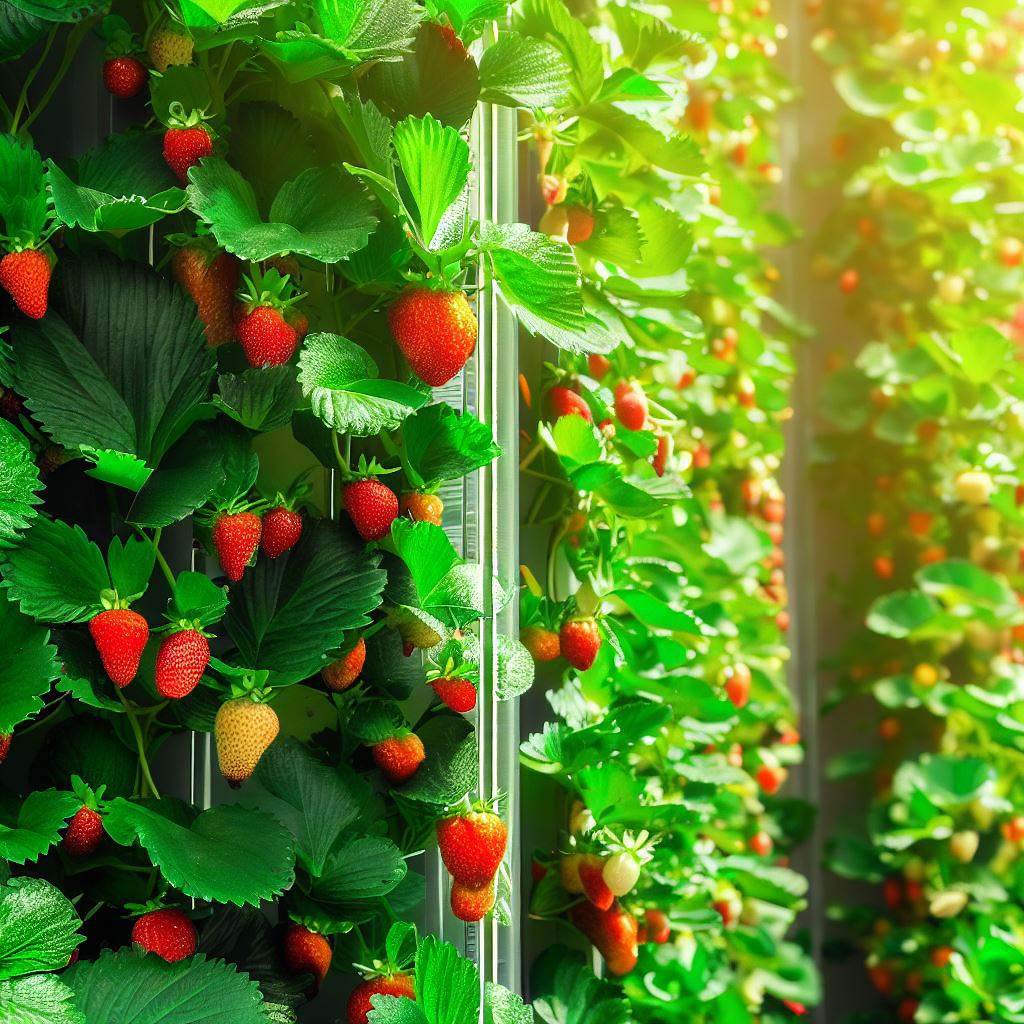
Success Tips for Hydroponic Strawberry Gardening
To maximize your success in hydroponic strawberry gardening, consider the following tips:
1. Consistency in monitoring and maintenance:
– Importance of regular monitoring and adjusting parameters.
2. Regular cleaning and sterilization of equipment:
– The significance of maintaining cleanliness to prevent disease and clogging.
3. Continuous learning and experimentation:
– The benefits of staying informed and trying new techniques or varieties.
By incorporating these tips into your hydroponic strawberry journey, you can achieve healthy plants, bountiful harvests, and a rewarding gardening experience.
Conclusion
Hydroponic strawberries offer a fantastic way to enjoy fresh, flavorful fruits year-round without the need for soil. With hydroponics, you can cultivate a greater quantity of strawberries in a smaller space, using less water and fertilizer compared to traditional soil-based methods. Additionally, hydroponics minimizes the risk of many common pest and disease issues associated with soil cultivation.
Nevertheless, it’s important to recognize that hydroponics requires a higher initial investment and more technical knowledge compared to soil-based growing. Maintaining a successful hydroponic strawberry system entails careful monitoring and adjustment of water, nutrients, light, temperature, pH, EC, and TDS levels.
To achieve successful growth of hydroponic strawberries, it is essential to follow these fundamental steps:
- Set up your hydroponic system designed for strawberries, ensuring you have sufficient space, light, and ventilation.
- Choose high-quality hydroponic strawberry seeds or runners from a reputable source and plant them according to the instructions provided.
- Provide proper care for your hydroponic strawberries, which includes monitoring and adjusting nutrient solution levels, pH, EC, temperature, and humidity to meet the plants’ specific requirements.
- Regularly check and maintain the health of your hydroponic strawberries by removing any dead or diseased plant parts promptly and ensuring adequate air circulation and light penetration.
- Once your hydroponic strawberries are ready for harvest, carefully pick the ripe fruits and store them appropriately to maintain their freshness and flavor.
By following these steps, you can savor the delightful taste and nutritional benefits of hydroponic strawberries throughout the year, enjoying a bountiful harvest of homegrown goodness.
FAQ
What are the best types of strawberries for hydroponics?
The best types of strawberries for hydroponics are day-neutral varieties such as Albion, Seascape, Everest, or Tribute. These varieties can produce fruits throughout the year regardless of the length of day and night.
How many strawberry plants can I grow in one square meter (10.8 square feet) of space?
The number of strawberry plants you can grow in one square meter of space depends on the type of system you use. Generally, you can grow between 16 and 25 plants per square meter.
How much water do I need for my hydroponic strawberries?
The amount of water required for hydroponic strawberries depends on the type of system you use. On average, you will need between 2 and 4 liters (0.5 and 1 gallon) of water per plant per week.
How much nutrient solution do I need for my hydroponic strawberries?
The amount of nutrient solution needed for hydroponic strawberries depends on the type of system you use. Typically, you will need between 100 and 200 milliliters (3.4 and 6.8 fluid ounces) of nutrient solution per plant per week.
How long does it take for hydroponic strawberries to grow?
The time from planting to harvest can vary, but generally, hydroponic strawberries take around 60-90 days to grow and produce ripe fruits.
Can I use tap water for hydroponic strawberry systems?
It is advisable to use filtered or dechlorinated water for hydroponic systems. Chlorine and other impurities in tap water can affect plant health.
What is the best lighting for hydroponic strawberry plants?
Full-spectrum LED grow lights are recommended for hydroponic strawberry cultivation. They provide the necessary light spectrum and energy efficiency.
Are hydroponic strawberries organic?
Hydroponic strawberries can be grown using organic practices, but certification as organic depends on adherence to specific organic standards and regulations.



